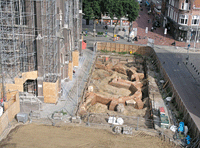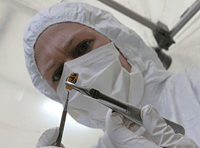
Posted on 10/16/2007 12:58:12 PM PDT by blam
Medieval DNA, Modern Medicine
Volume 60 Number 6, November/December 2007
by Heather Pringle
Will a cemetery excavation establish a link between the Black Death and resistance to AIDS?

Beneath Eindhoven's modern skin of brick and asphalt lie the bones of its medieval townspeople. Studying their DNA may reveal the origin of the genetic resistance to AIDS. (Courtesy Laurens Mulkens)
From the start, Nico Arts sensed that the frail remains of a child buried in front of a medieval church altar had an important story to tell. Arts is the municipal archaeologist in Eindhoven, a prosperous industrial city in the southern Netherlands whose medieval streets vanished long ago beneath a modern warren of concrete and steel. In the late winter of 2002, Arts and his team were conducting a test excavation near St. Catherine's Church in the city center, in advance of the development of a new public square. Arts believed he had found someone very important, such as the son or daughter of a former lord of Eindhoven. He persuaded forensic scientists at the University of Louvain in Belgium to test for ancient DNA. The chances of finding it seemed slim because water dissolves DNA, and the repeated pumping of groundwater from underground parking lots over the past decade could have periodically soaked the child's bones. But in 2004, Arts received some unexpected news: one of the child's milk teeth yielded DNA. It was the first time usable amounts of this molecule had been recovered from an ancient body in the Netherlands, and it showed the child was a boy.
This chance discovery of ancient DNA has led to one of the most ambitious archaeological projects ever to come out of the Netherlands--a massive excavation in the St. Catherine's Church cemetery and the establishment of a major ancient human DNA databank. With $3.4 million in funding, Arts and a team of archaeologists and physical anthropologists have now unearthed the skeletons of more than 750 Eindhoven citizens. And over the next two years, University of Leiden geneticist Peter de Knijff will attempt to recover DNA from these remains. "We expect that at least 75 percent of all individuals will have ancient DNA and proteins," says Arts.

Eveline Altena prepares to take a DNA sample from a recently excavated molar. The tooth's pulp cavity seals off DNA from contaminants, making it the best place to look for intact genetic samples. (Courtesy Laurens Mulkens)
For researchers, the Eindhoven DNA bank could prove a major windfall, paving the way for a host of new studies. To unravel the mysteries of human disease, researchers are increasingly studying genetic variations in human populations that increase the risk of illnesses, such as diabetes, or boost resistance to infections such as malaria. By studying the variants over time, researchers hope to advance knowledge of these diseases and gather clues to produce vaccines or new drug treatments. And such medical research is where the Eindhoven DNA bank, which spans 600 years of history, could really shine.
The Dutch team hopes, for example, that their project will reveal the origin and prevalence of a genetic variant that increases resistance to one of the world's most lethal viruses--HIV. Today, nearly 10 percent of people of northern European descent possess this variant, known as the CCR5D32 allele, and the discovery is sparking the development of a new class of AIDS-fighting drugs. Evidence suggests that this mutation first arose 3,100 to 7,800 years ago, but how did it become so prevalent across Europe in an age before the AIDS epidemic? Could this mutation also have boosted resistance to an earlier epidemic, such as smallpox or the Black Death? In search of new data, Knijff and his team will search for this variant in the DNA of Eindhoven's citizens. "There is no doubt that these studies are valuable," says Susan Scott, a University of Liverpool historian who has written extensively on the Black Death and its possible connection to the HIV-resistance variant. "Whilst I don't think [ancient DNA] studies will yield a vaccine for AIDS, they may assist molecular geneticists to develop some gene therapy."
For Arts and many of his colleagues, the bold project has ushered in a new era in archaeological research. "It makes archaeology much more relevant than it ever has been before," says Eveline Altena, a University of Leiden doctoral student in charge of recovering ancient DNA from the Eindhoven burials. "If we can use archaeological samples to answer medical questions, how cool is that?"
Heather Pringle is a freelance science journalist and author of Master Plan: Himmler's Scholars and the Holocaust.
|
|
|||
Gods |
Thanks Blam. |
||
|
· Mirabilis · Texas AM Anthropology News · Yahoo Anthro & Archaeo · · History or Science & Nature Podcasts · Excerpt, or Link only? · cgk's list of ping lists · |
|||
So, I guess I’m both. I sponsored my mother’s brother and he is R1b1 with DYS-390-23. I also sponsored my brother who turns out is R1b1 with a DYS-390-24.
It’s a good thing these remains aren’t American Indian or we’d have to rebury the bones and burn all the research.
“how cool is that?”
Sit on it, Fonzie.
BTTT
(Which means, death rate per population infected, or death rate of the population with cause unknown. Either definition works here.)
Consequently the tax authorities came up with a scheme of hiring Sa'ami to open up farms to the South where all the Norse people had died. They also had Sa'ami take over fishing boats, forests, etc.
The last farms made vacant by plague were opened up by Sa'ami settlers from the far North in the mid 1700s.
That was about 350 years worth of difference.
(Subtle nuances between different sorts of expressions of death rate are rather meaningless in this situation).
Roughly, the Sa'ami appear not to have been affected by the Black Death while the Norse were slaughtered like lambs in a Kosovan slaughter house the week before Ramadan.
Given that the Sa'ami have substantial and significant genetic differences from the Norse, and a myriad of epigenetic differences, you almost have to suspect the Sa'ami had a pre-existing genetic difference that protected them against Black Death whatever it might have been.
From the Sa'ami point of view the relocation back to the South was a mixed blessing. On the one hand the entire Sa'ami population was able to move firmly into the Iron age, but on the other they began to lose their distinct cultural identity (Little Red Man, Herb Woman, Reindeer Man), but not their genome ~ and it's only recently that it's been rediscovered.
I too am into genealogy and have thought about this, but as you say, it is rather expensive.
DYS-392-13. What does 13 mean at 392?
I don't understand it either, lol. My neighbor is a yDNA I1a and has a DYS390-23 just like me and I'm an R1b.
"The J2 lineage originated in the northern portion of the Fertile Crescent where it later spread throughout central Asia, the Mediterranean, and south into India. As with other populations with Mediterranean ancestry this lineage is found within Jewish populations. Research note: Many people new to Genetic Genealogy think the J2 haplogroup is synonymous with having male Jewish ancestry. One should note that having a J2 haplogroup assignment does not necessarily indicate Jewish ancestry. The J2 haplogroup is far more ancient than the Jewish religion and is found in many lines with Mediterranean region ancient ancestry. Another relatively more recent mode for J2's entry into some parts of Europe from the Mediterranean areas could have been the Roman Legions and Roman settlements."
BTW- My whole family on both sides has blond hair and blue eyes with the occasional redhead mixed in. I’ve had allot of fun telling them we’re probably Jewish and come from the middle east.
LOL. I know the feeling.
Imagine my family's suprise when I told them that my mother (A south Alabama farm girl) was a Sa'ami!!! They said, "A WHAT?" They started getting closer to understanding when I used the word 'Laplander' and reindeer herder. My mother is haplogroup 'V'...a Skolt Sa'ami.

Sa'ami Girl
Were those movements reflected in the bygdeboks?
Also, if you think you may eventually be wanting to go as high as a 37 marker test, it's cheaper to do it initially than upgrading later. I've learned some of these things the more expensive way!
GENOMEThe different kind blood group you have determines your susceptibility to certain diseases. For example, people with A blood are less likely to get diarrhoea than people with B blood. People with O blood are more susceptible to getting diarrhoea than anybody else. People with AB blood are virtually immune to diarrhoea because of their resistance. Nobody really yet knows how AB genotype protects them from this disease. "Since people with the O blood are the most susceptible to the disease, shouldn't they die out according to natural selection?' you are probably asking. That is true but there are a couple of things that keep the O group alive and one of them is malaria. People with O blood are more resistant to malaria than other groups. Another thing is that the O group is less likely to get certain cancers. These benefits cancel out the negative effect that the O blood group has on the diarrhoea disease so, this balance has kept the group from disappearing.
the autobiography of
a species in 23 chapters
by Matt Ridley
(from chap 9)
Disclaimer: Opinions posted on Free Republic are those of the individual posters and do not necessarily represent the opinion of Free Republic or its management. All materials posted herein are protected by copyright law and the exemption for fair use of copyrighted works.